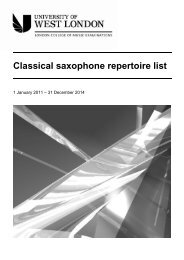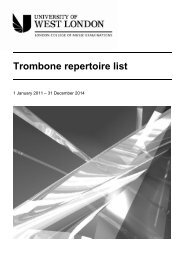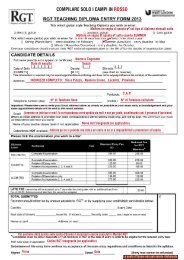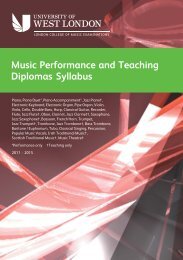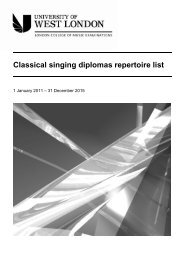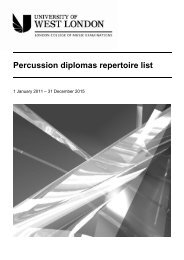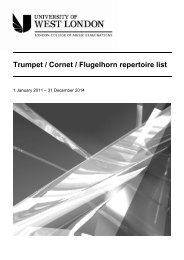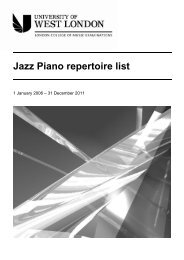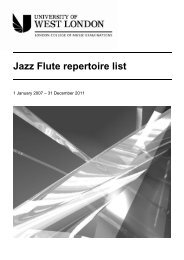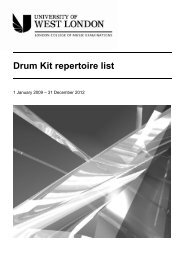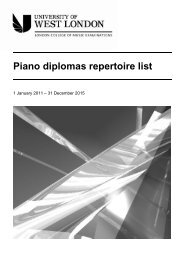LCM Exams - Clarinet Grades repertoire list - esamilcm.it
LCM Exams - Clarinet Grades repertoire list - esamilcm.it
LCM Exams - Clarinet Grades repertoire list - esamilcm.it
Create successful ePaper yourself
Turn your PDF publications into a flip-book with our unique Google optimized e-Paper software.
<strong>Clarinet</strong> <strong>repertoire</strong> <strong>list</strong><br />
1 January 2011 – 31 December 2014
CLARINET<br />
2011-2014<br />
Contents<br />
Page<br />
<strong>LCM</strong> Publications ................................................................ 3<br />
Related Examinations ......................................................... 3<br />
Introduction ......................................................................... 3<br />
Step 1 .................................................................................. 4<br />
Step 2 .................................................................................. 5<br />
Grade 1 ............................................................................... 6<br />
Grade 2 ............................................................................... 8<br />
Grade 3 ............................................................................... 10<br />
Grade 4 ............................................................................... 12<br />
Grade 5 ............................................................................... 14<br />
Grade 6 ............................................................................... 16<br />
Grade 7 ............................................................................... 18<br />
Grade 8 ............................................................................... 20<br />
Viva Voce ............................................................................ 22<br />
Aural Tests .......................................................................... 24<br />
This <strong>repertoire</strong> <strong>list</strong> should be read in conjunction w<strong>it</strong>h the Syllabus for<br />
Graded and Leisure Play Examinations in Music Performance. Copies<br />
are available free of charge from <strong>LCM</strong> Examinations (tel: 020 8231 2364)<br />
or from local representatives, or on uwl.ac.uk/lcmexams.<br />
Leisure Play examinations are also available, for candidates who wish to<br />
play pieces only. Please see Section 5 of the syllabus for details.<br />
This <strong>repertoire</strong> <strong>list</strong> is valid from 1 January 2011 until 31 December 2014.
<strong>LCM</strong> Examinations<br />
Director of Examinations<br />
John Howard BA PhD<br />
Chief Examiner in Music<br />
Philip Aldred BEd F<strong>LCM</strong><br />
Univers<strong>it</strong>y of West London<br />
<strong>LCM</strong> Examinations<br />
St Mary’s Road<br />
Ealing<br />
London<br />
W5 5RF<br />
tel: +44 (0)20 8231 2364<br />
fax: +44 (0)20 8231 2433<br />
email: lcm.exams@uwl.ac.uk<br />
uwl.ac.uk/lcmexams<br />
© Copyright 2011 by the Univers<strong>it</strong>y of West London, <strong>LCM</strong> Examinations<br />
2
Acknowledgement<br />
Grateful thanks are due to Stuart Corbett, the principal syllabus compiler.<br />
<strong>LCM</strong> Publications<br />
The following <strong>LCM</strong> Publications are relevant to this syllabus:<br />
• Specimen <strong>Clarinet</strong> Sight Reading Tests: <strong>Grades</strong> and Diplomas (LL11881)<br />
• Specimen Aural Tests (LL189)<br />
• <strong>LCM</strong> Aural Handbook: A Practical Guide to Teaching and Preparing for <strong>LCM</strong> Aural Tests (LL205)<br />
<strong>LCM</strong> Publications are distributed by Music Exchange (tel: 0161 946 9301; email: mail@music-exchange.co.uk).<br />
A complete <strong>list</strong> of t<strong>it</strong>les may be found on their webs<strong>it</strong>e – www.music-exchange.co.uk<br />
Related Examinations<br />
<strong>LCM</strong> Examinations offers examinations in a wide range of subjects, covering classical, jazz, pop/rock and<br />
trad<strong>it</strong>ional music genres. The following syllabuses may also be of interest:<br />
• Graded and leisure play examinations for jazz clarinet<br />
• Performance diplomas (four levels) for clarinet and jazz clarinet<br />
• Teaching diplomas (three levels) for clarinet and jazz clarinet<br />
A flexible Ensemble syllabus is also available, catering for all types of ensemble from duets and trios up to concert<br />
bands and wind bands. Six levels are offered, ranging from <strong>Grades</strong> 1-2 to Dip<strong>LCM</strong> standard.<br />
Syllabuses are available free of charge from the <strong>LCM</strong> <strong>Exams</strong> office or from local representatives, or may be<br />
downloaded from the <strong>LCM</strong> <strong>Exams</strong> webs<strong>it</strong>e.<br />
Introduction<br />
This syllabus has been designed to encourage candidates to explore many areas of study, encompassing the<br />
trad<strong>it</strong>ions of the Baroque, Classical and Romantic periods. In add<strong>it</strong>ion, contemporary works and music in jazz<br />
idioms are included.<br />
Where indicated, pieces which are supported by a CD backing track can also be performed w<strong>it</strong>h an accompanist, if<br />
preferred. It is the candidate’s responsibil<strong>it</strong>y to provide su<strong>it</strong>able audio equipment if CD backing is used. See<br />
syllabus regulations.<br />
Duets are included in the early grades in order to encourage ensemble awareness. The teacher or another student<br />
should play the lower line.<br />
Pieces in List B should generally be accompanied, unless indicated otherwise.<br />
If a piece appears at more than one grade, greater skill levels and interpretation qual<strong>it</strong>ies will be expected at the<br />
higher grade.<br />
3
CLARINET: STEP ONE<br />
Candidates may use a Bb <strong>Clarinet</strong> or any su<strong>it</strong>able beginner instrument, such as the Lyons C <strong>Clarinet</strong>.<br />
The exercises must both be taken from the same book. The pieces may be taken from any of the set books. Some<br />
of the pieces and/or exercises are duets. This is to encourage ensemble awareness. The teacher or a friend may<br />
wish to play the lower part, which will not be assessed.<br />
Component 1 - Exercises<br />
25 marks<br />
E<strong>it</strong>her: Ex.1 and Ex.2 (un<strong>it</strong> 5, page 14, slurs) Learn As You Play <strong>Clarinet</strong> (Boosey & Hawkes)<br />
Or: Ex.3 and Ex.4 (level 1) studies Teacher On Tap Book 1: Starting Out (Teacher On Tap)<br />
Or: No.4 and No.5 (lesson 5A, page 9, slurred notes)<br />
A Tune A Day <strong>Clarinet</strong><br />
(Boston Music / Music Sales)<br />
Component 2 - Pieces<br />
60 marks<br />
Any three to be chosen.<br />
Irish Lullaby (page 8) Fifty Five for Fun [solo clarinet] (Fentone / De Haske)<br />
Oranges and Lemons (page 8) Fifty Five for Fun [solo clarinet] (Fentone / De Haske)<br />
A L<strong>it</strong>tle Piece (Schumann) (un<strong>it</strong> 5) Learn As You Play <strong>Clarinet</strong> (Boosey & Hawkes)<br />
Aria (Gluck) (un<strong>it</strong> 5) Learn As You Play <strong>Clarinet</strong> (Boosey & Hawkes)<br />
Soka (w<strong>it</strong>h CD backing or accompanied) Teacher On Tap Book 1: Starting Out (Teacher On Tap)<br />
Twinkle Twinkle L<strong>it</strong>tle Star (lesson 5, page 8) A Tune A Day <strong>Clarinet</strong> (Boston Music / Music Sales)<br />
The Boat Song (lesson 5, page 8) A Tune A Day <strong>Clarinet</strong> (Boston Music / Music Sales)<br />
Lightly Row (lesson 5A) A Tune A Day <strong>Clarinet</strong> (Boston Music / Music Sales)<br />
Component 3 - Questions on Rudiments<br />
15 marks<br />
Recogn<strong>it</strong>ion/identification of stave, barlines, p<strong>it</strong>ch names, note types and values, rest values, all relating to the<br />
music performed. The importance of looking after the instrument (e.g. keeping the mouthpiece clean, the pullthrough,<br />
looking after reeds).<br />
4
CLARINET: STEP TWO<br />
Candidates may use a Bb <strong>Clarinet</strong> or any su<strong>it</strong>able beginner instrument, such as the Lyons C <strong>Clarinet</strong>.<br />
The exercises must both be taken from the same book. The pieces may be taken from any of the set books. Some<br />
of the pieces and/or exercises are duets. This is to encourage ensemble awareness. The teacher or a friend may<br />
wish to play the lower part, which will not be assessed.<br />
Component 1 - Exercises<br />
25 marks<br />
Scale and arpeggio of G major (tongued and slurred), one octave ascending and descending, from memory<br />
[illustrated in Learn As You Play <strong>Clarinet</strong>, un<strong>it</strong> 8, page 29]<br />
and<br />
E<strong>it</strong>her: Ex.1 and Ex.2 (un<strong>it</strong> 7, page 18, B flat) Learn As You Play <strong>Clarinet</strong> (Boosey & Hawkes)<br />
Or: Ex.8 and Ex.9 (level 1) studies Teacher On Tap Book 1: Starting Out (Teacher On Tap)<br />
Or: Ex.3 and Ex.8 (lesson 9, pages 14-15) A Tune A Day <strong>Clarinet</strong> (Boston Music / Music Sales)<br />
Component 2 - Pieces<br />
60 marks<br />
Any three to be chosen.<br />
Johnny Todd (page 14) Fifty Five for Fun [solo clarinet] (Fentone / De Haske)<br />
Amazing Grace (page 17) Fifty Five for Fun [solo clarinet] (Fentone / De Haske)<br />
Duo [duet, upper part] (un<strong>it</strong> 7) Learn As You Play <strong>Clarinet</strong> (Boosey & Hawkes)<br />
Melody in a Phrygian Mode (Bartók) Learn As You Play <strong>Clarinet</strong> (Boosey & Hawkes)<br />
Introducing the Eighth Note (Quaver) (w<strong>it</strong>h CD backing or accompanied)<br />
Teacher On Tap Book 1: Starting Out (Teacher On Tap)<br />
Abide W<strong>it</strong>h Me (lesson 6, page 11) A Tune A Day <strong>Clarinet</strong> (Boston Music / Music Sales)<br />
Lightly Row (lesson 6, page 11) A Tune A Day <strong>Clarinet</strong> (Boston Music / Music Sales)<br />
Au Clair de la Lune [duet, upper part] (lesson 6) A Tune A Day <strong>Clarinet</strong><br />
(Boston Music / Music Sales)<br />
Component 3 - Questions on Rudiments<br />
15 marks<br />
As for Step 1, including looking after the instrument, plus dotted note values and knowledge about the purpose of<br />
the key signature and time signature, accidentals and basic dynamic signs. All relating to the music performed.<br />
5
CLARINET: GRADE ONE<br />
Component 1 - Technical Work<br />
15 marks<br />
Scales and Arpeggios (ascending and descending from memory)<br />
(suggested tempo: m.m. crotchet = 60 when played in quavers)<br />
to be played tongued and slurred:<br />
G and F major (one octave); A minor (one octave) [harmonic OR melodic minor scale, at candidate’s choice]<br />
Component 2 - Performance<br />
60 marks<br />
Performance of three pieces: one piece from List A and two contrasting pieces from List B.<br />
LIST A<br />
DEMNITZ No.2 OR No.3 OR No.4 (p.3) from Elementary School for <strong>Clarinet</strong> (Peters)<br />
GLUCK Aria (p.15) from Learn As You Play <strong>Clarinet</strong> (Boosey & Hawkes)<br />
GUMBLEY Frog Hop OR First Base from Cool School (<strong>Clarinet</strong>) (Brass Wind)<br />
LAWRANCE Russian Dance from Winners Galore (<strong>Clarinet</strong>) (Brass Wind)<br />
LEWIN<br />
I Had a L<strong>it</strong>tle Dove OR Lady Owen’s Delight OR Cantilena Song from Studies for <strong>Clarinet</strong><br />
(ABRSM)<br />
LYONS No.4 from <strong>Clarinet</strong> Studies (Useful Music U30)<br />
NIGHTINGALE A Small Step OR Coo’s Blues OR Ready Aim Fire from Easy Jazzy ‘Tudes (Warwick Music)<br />
PERCIVAL Ex.4 OR Ex.5 OR Ex.6 (Level 2) studies from Teacher On Tap Book 1: Starting Out<br />
(Teacher On Tap)<br />
RAE Proclamation OR First Waltz from Style Workout for Solo <strong>Clarinet</strong> (Universal)<br />
RAE Spir<strong>it</strong>ual OR Diggin' Deep (Lesson 10, p29) from Introducing the <strong>Clarinet</strong> (Universal 165851)<br />
RAE<br />
Undercover (No.2) OR Backtrack (No.5) from 40 Modern Studies for Solo <strong>Clarinet</strong><br />
(Universal)<br />
REYNOLDS March OR Moderato from The <strong>Clarinet</strong>tist’s Progress Book 1 (Hunt Ed<strong>it</strong>ion)<br />
LIST B<br />
CHAMBERLAIN Rollerblading from Step It Up (Faber)<br />
COURT Autumn Leaves from First Rec<strong>it</strong>al Series (Curnow)<br />
GLUCK Chorus from Paris and Helen from Learn As You Play <strong>Clarinet</strong> (Boosey & Hawkes)<br />
HOUNSOME Activate OR Spirals from Upbeat! for <strong>Clarinet</strong> Book 1 (Music Exchange)<br />
JOHNSON Reflections from First Rec<strong>it</strong>al Series (Curnow)<br />
LEFEVRE March from Music Through Time for <strong>Clarinet</strong> Book 1 (Harris) (OUP)<br />
LYONS Nutty Flavour OR Miss P Dolce from New <strong>Clarinet</strong> Solos Book 1 (Useful Music)<br />
NORTON Promises from Microjazz Collection Book 2 (Boosey & Hawkes)<br />
NORTON Soldier Boy OR Under A Cloud from Microjazz Collection Book 1 (Boosey & Hawkes)<br />
PERCIVAL Nashville Express OR Valse Veird from Teacher On Tap Book 1: Starting Out (Teacher On Tap)<br />
PURCELL Rigaudon from Ten Easy Tunes for <strong>Clarinet</strong> (arr. Griff<strong>it</strong>hs) (Fentone / De Haske)<br />
PURCELL Song from Music Through Time for <strong>Clarinet</strong> Book 1 (Harris) (OUP)<br />
RAE Miss Natalie OR Evening Breeze from Latin <strong>Clarinet</strong> (Universal)<br />
READE Romance from First Book of <strong>Clarinet</strong> Solos (Faber)<br />
SCHUMANN Humming Song from Learn As You Play <strong>Clarinet</strong> (Boosey & Hawkes)<br />
TRAD. Kalinka from Ten Easy Tunes for <strong>Clarinet</strong> (arr. Griff<strong>it</strong>hs) (Fentone / De Haske)<br />
TRAD. Riddle Song from The Joy of <strong>Clarinet</strong> (Yorktown / Music Sales)<br />
TRAD. Riding On A Donkey OR Hatikvah OR Pierrot from First Book of <strong>Clarinet</strong> Solos (Faber)<br />
TRAD. Shepherd’s Hey from First Book of <strong>Clarinet</strong> Solos (Faber)<br />
Component 3 - Viva Voce<br />
7 marks<br />
See pages 22-23.<br />
6
Component 4 - Sight Reading<br />
10 marks<br />
Up to one minute’s preparation time will be allowed to study the test before playing, during which the candidate may try<br />
parts of the test if they wish. Specimen tests are available (LL11881).<br />
Component 5 - Aural Tests<br />
8 marks<br />
See pages 24-28. Specimen tests and a handbook are available (details on page 3).<br />
7
CLARINET: GRADE TWO<br />
Component 1 - Technical Work<br />
15 marks<br />
Scales and Arpeggios (ascending and descending from memory)<br />
(suggested tempo: m.m. crotchet = 60 when played in quavers)<br />
to be played tongued and slurred:<br />
G and F major (two octaves)<br />
C major (one octave)<br />
A and D minor (one octave) [harmonic OR melodic minor scale, at candidate’s choice]<br />
Component 2 - Performance<br />
60 marks<br />
Performance of three pieces: one piece from List A and two contrasting pieces from List B.<br />
LIST A<br />
DEMNITZ No.5 OR No.6 OR No.7 (p.4) from Elementary School for <strong>Clarinet</strong> (Peters Ed<strong>it</strong>ion P2417)<br />
GLUCK March from Starters for <strong>Clarinet</strong> (arr. Lewin) (ABRSM)<br />
GUMBLEY Tongue and Groove from Cool School (Brass Wind)<br />
LANGEY Ex.45 (w<strong>it</strong>h triplets) (p.35) from The <strong>Clarinet</strong> (Boosey & Hawkes)<br />
LAWRANCE Theme from William Tell (p.4) OR Rondo (p.6) from Winners Galore (Clarient) (Brass Wind)<br />
LULLY Ariette from Learn As You Play <strong>Clarinet</strong> (Boosey & Hawkes)<br />
LYONS No.9 OR No.26 from <strong>Clarinet</strong> Studies (Useful Music U30)<br />
NIGHTINGALE Three Step OR The Stinger OR Big Mama from Easy Jazzy ‘Tudes (Warwick Music)<br />
PERCIVAL Ex.2 OR Ex.3 OR Ex.6 (Level 3) from Teacher On Tap Book 1: Starting Out (Teacher On Tap)<br />
RAE In The Fast Lane (Lesson 13, p.35) from Introducing the <strong>Clarinet</strong> (Universal)<br />
RAE Jig in C (No.5) OR Open Spaces (No.6) from Style Workout for Solo <strong>Clarinet</strong> (Universal)<br />
RAE The Big One OR Slow Motion from 40 Modern Studies for Solo <strong>Clarinet</strong> (Universal)<br />
REYNOLDS Allegretto (No.4) OR Andantino (No.5) from The <strong>Clarinet</strong>tist’s Progress Book 1 (Hunt Ed<strong>it</strong>ion)<br />
LIST B<br />
ALAN Legend from 1st Rec<strong>it</strong>al Series (<strong>Clarinet</strong>) (Curnow)<br />
CHAMBERLAIN The Red Admiral OR O Soldier Soldier from Step It Up (Faber)<br />
DANZI Potpourri from First Repertoire for <strong>Clarinet</strong> (Harris & Johnson) (Faber)<br />
DAVIES & READE Finnish Folksong OR Merry Peasant from First Book of <strong>Clarinet</strong> Solos<br />
(Faber)<br />
HOUNSOME Musical Box from Upbeat! for <strong>Clarinet</strong> Book 1 (Music Exchange)<br />
KABALEVSKY Ch<strong>it</strong>-Chat from Joy of <strong>Clarinet</strong> (Music Sales)<br />
LINDSAY Crab Apple Crossing from 1st Rec<strong>it</strong>al Series (<strong>Clarinet</strong>) (Curnow)<br />
LYONS Bonjour OR Velvet from New <strong>Clarinet</strong> Solos Vol.2 (Useful Music)<br />
NORTON Tread Softly from Microjazz Book 2 (Boosey & Hawkes)<br />
PLEYEL Minuet from <strong>Clarinet</strong> Fancies (Boston Music / Music Sales)<br />
PURCELL Lilliburlero from Music Through Time Book 2 (OUP)<br />
PURCELL Rigaudon from <strong>Clarinet</strong> Fancies (Boston Music / Music Sales)<br />
RAE Lost In The Clouds from Blue <strong>Clarinet</strong> (Universal 19764)<br />
RAE Winter Sun OR Blue Habanera from Latin <strong>Clarinet</strong> (Universal 17383)<br />
REINECKE Landler from First Book of <strong>Clarinet</strong> Solos (Faber)<br />
SCHUBERT The Trout from The Joy of <strong>Clarinet</strong> (Yorktown / Music Sales)<br />
TRAD. Marian from The Joy Of <strong>Clarinet</strong> (Yorktown / Music Sales)<br />
TRAD. When The Saints from The Joy of <strong>Clarinet</strong> (Yorktown / Music Sales)<br />
VAUGHAN WILLIAMS<br />
No.2 (Andante Sostenuto) from Six Studies in English Folksong<br />
(Stainer & Bell)<br />
WEDGWOOD Take It Easy OR Land of Hope and Glory from Up-Grade! <strong>Clarinet</strong> <strong>Grades</strong> 1-2 (Faber)<br />
WEILL September Song from What Else Can I Play Grade 2 (Faber)<br />
8
Component 3 - Viva Voce<br />
7 marks<br />
See pages 22-23.<br />
Component 4 - Sight Reading<br />
10 marks<br />
Up to one minute’s preparation time will be allowed to study the test before playing, during which the candidate may try<br />
parts of the test if they wish. Specimen tests are available (LL11881).<br />
Component 5 - Aural Tests<br />
8 marks<br />
See pages 24-28. Specimen tests and a handbook are available (details on page 3).<br />
9
CLARINET: GRADE THREE<br />
Component 1 - Technical Work<br />
15 marks<br />
Scales and Arpeggios (ascending and descending from memory)<br />
(suggested tempo: m.m. crotchet = 60 when played in quavers)<br />
to be played tongued and slurred:<br />
G, F, A and B flat major (two octaves)<br />
A, E and G minor (two octaves) [harmonic OR melodic minor scales, at candidate’s choice]<br />
Chromatic scale starting on G (one octave)<br />
Component 2 - Performance<br />
60 marks<br />
Performance of three pieces: one piece from List A and two contrasting pieces from List B.<br />
LIST A<br />
DEMNITZ No.4 (p.9) OR No.10 (p.8) from Elementary School for <strong>Clarinet</strong> (Peters Ed<strong>it</strong>ion 2417)<br />
GUMBLEY Puddle Jump from Cool School: <strong>Clarinet</strong> (Brass Wind)<br />
KÁROLYI Dance (p.45) from Learn As You Play <strong>Clarinet</strong> (Boosey & Hawkes)<br />
LANGEY Ex.35 (Scale of D minor section, p.29) from The <strong>Clarinet</strong> (Boosey & Hawkes)<br />
LAWRANCE Prelude (p.11) OR Radetzky March (p.18) from Winners Galore (<strong>Clarinet</strong>) (Brass Wind)<br />
LEWIN Sweet Sorrow OR La Biondina from Starters for <strong>Clarinet</strong> (ABRSM)<br />
LYONS No.28 OR No.30 from <strong>Clarinet</strong> Studies (Useful Music U30)<br />
NIGHTINGALE Ernie’s Blues OR Skipping OR Slinky from Easy Jazzy ‘Tudes (Warwick Music)<br />
PERCIVAL Ex.1 OR Ex.5 OR Ex.7 (Level 5) from Teacher On Tap Book 1: Starting Out (Teacher On Tap)<br />
RAE Chandelier Waltz OR Strange But True from Style Workout for Solo <strong>Clarinet</strong> (Universal)<br />
RAE<br />
In The Beginning OR Passing Time OR Forever from 40 Modern Studies<br />
for Solo <strong>Clarinet</strong><br />
(Universal)<br />
REYNOLDS Crisply (No.12) OR Moderato (No.13) from The <strong>Clarinet</strong>tist’s Progress Book 1 (Hunt Ed<strong>it</strong>ion)<br />
SPARKE Hymn No.1 (No.15) OR Hymn No.2 (No.16) from Super Studies (Anglo Music / De Haske)<br />
TRAD. Londonderry Air (p.68) from Introducing the <strong>Clarinet</strong> [as solo] (arr. Rae) (Universal 165851)<br />
WESTON No.5 OR No.6 from 50 Classical Studies (Fentone / De Haske)<br />
LIST B<br />
BACH Air from Su<strong>it</strong>e No.3 from 1st Rec<strong>it</strong>al Series (<strong>Clarinet</strong>) (Curnow)<br />
BEETHOVEN Ecossaise from <strong>Clarinet</strong> Fancies (Boston Music / Music Sales)<br />
BRITTEN Burlesque from First Repertoire for <strong>Clarinet</strong> (Harris & Johnson) (Faber)<br />
CHOPIN Nocturne from The Joy of <strong>Clarinet</strong> (Yorktown / Music Sales)<br />
FINZI Carol from Five Bagatelles (Boosey & Hawkes)<br />
FOSTER Beautiful Dreamer from First Book of <strong>Clarinet</strong> Solos (Faber)<br />
GERSHWIN Summertime from Easy Gershwin for <strong>Clarinet</strong> (OUP)<br />
HANNICKEL Chalumeau on the Go from 1st Rec<strong>it</strong>al Series (<strong>Clarinet</strong>) (Curnow)<br />
HARVEY Swinging Quavers OR Shorty from Easy Jazzy <strong>Clarinet</strong> (Universal 19214)<br />
HOUNSOME Just Lounging About OR Highland Capers from Upbeat Book 1 (Music Exchange)<br />
JOHNSON & BURKE<br />
Pennies from Heaven from Play Jazztime<br />
(Faber)<br />
KELLY Argumentative from Mood Pieces (Stainer & Bell)<br />
LEDBURY Short Cut OR Evergreen from All Jazzed Up (Brass Wind)<br />
LEHAR Vilia from The Joy of <strong>Clarinet</strong> (Yorktown / Music Sales)<br />
MOZART Aria from Don Giovanni from The Joy of <strong>Clarinet</strong> (Yorktown / Music Sales)<br />
MOZART Il Mio Tesoro from <strong>Clarinet</strong> Solos Vol.1 (Chester / Music Sales)<br />
MOZART Minuet And Trio from Divertimento No.1 (Chester / Music Sales)<br />
MOZART Sonata Theme OR Minuet from <strong>Clarinet</strong> Fancies (Boston Music / Music Sales)<br />
PERCIVAL<br />
Air OR El Gato OR Last Tango in Coonabarabran from Teacher On Tap Book 1: Starting Out<br />
(Teacher On Tap)<br />
RAE Coffee Time from Latin <strong>Clarinet</strong> (Universal)<br />
RAMEAU 2me Sarabande from Su<strong>it</strong>e [w<strong>it</strong>hout the DC to 1re Sarabande] (Boosey & Hawkes)<br />
TCHAIKOVSKY Reverie from First Book of <strong>Clarinet</strong> Solos (Faber)<br />
VAN GORP The Henley Regatta OR Go Out Shopping from Master Swop (De Haske)<br />
[to be performed w<strong>it</strong>h CD backing or piano accompaniment]<br />
WALTON Song At Dusk from Music Through Time Book 2 (OUP)<br />
10
Component 3 - Viva Voce<br />
7 marks<br />
See pages 22-23.<br />
Component 4 - Sight Reading<br />
10 marks<br />
Up to one minute’s preparation time will be allowed to study the test before playing, during which the candidate may try<br />
parts of the test if they wish. Specimen tests are available (LL11881).<br />
Component 5 - Aural Tests<br />
8 marks<br />
See pages 24-28. Specimen tests and a handbook are available (details on page 3).<br />
11
CLARINET: GRADE FOUR<br />
Component 1 - Technical Work<br />
15 marks<br />
Scales and Arpeggios (ascending and descending from memory)<br />
(suggested tempo: m.m. crotchet = 72 when played in quavers)<br />
to be played tongued and slurred:<br />
C, G, D, F, A and B flat major (two octaves)<br />
E, D, B and G minor (two octaves) [harmonic OR melodic minor scales at candidate’s choice]<br />
Chromatic scale starting on F (two octaves)<br />
Dominant 7th in the key of C (two octaves)<br />
Component 2 - Performance<br />
60 marks<br />
Performance of three pieces: one piece from List A and two contrasting pieces from List B.<br />
LIST A<br />
DEMNITZ No.2 (p.10) OR No.5 (p.12) from Elementary School For <strong>Clarinet</strong> (Peters Ed<strong>it</strong>ion P2417)<br />
GUMBLEY Zig Zag OR Haunting Cool from Cool School (Brass Wind)<br />
LANGEY Ex.1 OR Ex.2 (w<strong>it</strong>h arpeggios, p.75) from The <strong>Clarinet</strong> (Boosey & Hawkes)<br />
ILYNSKY Berceuse from Starters for <strong>Clarinet</strong> (arr. Lewin) (ABRSM)<br />
LYONS No.29 OR No.32 from <strong>Clarinet</strong> Studies (Useful Music U30)<br />
NIGHTINGALE Hill Billy OR Passion Fru<strong>it</strong> Samba from Easy Jazzy ‘Tudes (Warwick Music)<br />
PERCIVAL Ex.6 OR Ex.7 OR Ex.8 (Level 6) from Teacher On Tap Book 1: Starting Out (Teacher On Tap)<br />
RAE Scale Model OR Epilogue from Style Workout for Solo <strong>Clarinet</strong> (Universal)<br />
RAE Tumbledown Blues OR Ted’s Shuffle from 40 Modern Studies for Solo <strong>Clarinet</strong> (Universal)<br />
REYNOLDS Landler (No.14) OR Allegretto (No.17) OR Lilting (No.19) OR Brightly (No.20)<br />
from The <strong>Clarinet</strong>tist’s Progress Book 1<br />
(Hunt Ed<strong>it</strong>ion)<br />
SCHUMANN First Loss from Learn As You Play <strong>Clarinet</strong> (Boosey & Hawkes)<br />
SPARKE Aria (No.7) from Super Studies (Anglo Music / De Haske)<br />
TRAD. The Groves of Blarney from Starters for <strong>Clarinet</strong> (arr. Lewin) (ABRSM)<br />
WESTON No.8 OR No.10 from 50 Classical Studies (Fentone / De Haske)<br />
LIST B<br />
BIZET Habanera from 1st Rec<strong>it</strong>al Series (<strong>Clarinet</strong>) (Curnow)<br />
BRUCH Swedish Dance from First Repertoire for <strong>Clarinet</strong> (Harris & Johnson) (Faber)<br />
CORELLI Sarabande from The Joy of <strong>Clarinet</strong> (Yorktown / Music Sales)<br />
CURNOW Soaring from 1st Rec<strong>it</strong>al Series (<strong>Clarinet</strong>) (Curnow)<br />
DUNHILL No.1 Andante Espressivo from Phantasy Su<strong>it</strong>e (Boosey & Hawkes)<br />
FERGUSON Pastoral from Four Short Pieces (Boosey & Hawkes)<br />
KELLY Cheerful from Mood Pieces (Stainer & Bell)<br />
KELLY Sarabande from Don Quixote Su<strong>it</strong>e (Emerson)<br />
LABOR Allegretto from Quintet from <strong>Clarinet</strong> Solos Vol.1 (Chester / Music Sales)<br />
LEFEVRE Sonata No.1 (Movt.3 only) from Second Book Of <strong>Clarinet</strong> Solos (Faber)<br />
MENDELSSOHN Venetian Boat Song from The Joy of <strong>Clarinet</strong><br />
(Yorktown / Music Sales)<br />
PERCIVAL Adagio OR Polka in G from Teacher On Tap Book 1: Starting Out (Teacher On Tap)<br />
PORTER Night and Day from First Repertoire for <strong>Clarinet</strong> (Harris & Johnson) (Faber)<br />
RAE Blue Bird from Blue <strong>Clarinet</strong> (Universal 19764)<br />
RAMEAU 1re Sarabande and 2me Sarabande OR 1er Minuet from Su<strong>it</strong>e (Boosey & Hawkes)<br />
[w<strong>it</strong>hout repeats, but w<strong>it</strong>h the DC]<br />
REGER Romance (No.13) from Second Book Of <strong>Clarinet</strong> Solos (Faber)<br />
SCHUBERT / BÄERMANN<br />
Serenade from <strong>Clarinet</strong> Concert Pieces<br />
(Fentone F270 / De Haske)<br />
SCHUBERT Waltz from Music Through Time Book 3 (OUP)<br />
TELEMANN Vivace from First Repertoire for <strong>Clarinet</strong> (Harris & Johnson) (Faber)<br />
VAN GORP This is My Day OR Por Favor from Master Swop (De Haske)<br />
[to be performed w<strong>it</strong>h CD backing or piano accompaniment]<br />
WALKER Round Dance from Jack Brymer <strong>Clarinet</strong> Series (Easy) Book 1 (Weinberger / Faber)<br />
WEBER Air from Der Freischutz from Learn As You Play <strong>Clarinet</strong> (Boosey & Hawkes)<br />
WOLF-FERRARI Romance from Jack Brymer <strong>Clarinet</strong> Series (Easy) Book 2<br />
(Weinberger / Faber)<br />
12
Component 3 - Viva Voce<br />
7 marks<br />
See pages 22-23.<br />
Component 4 - Sight Reading<br />
10 marks<br />
Up to one minute’s preparation time will be allowed to study the test before playing, during which the candidate may try<br />
parts of the test if they wish. Specimen tests are available (LL11881).<br />
Component 5 - Aural Tests<br />
8 marks<br />
See pages 24-28. Specimen tests and a handbook are available (details on page 3).<br />
13
CLARINET: GRADE FIVE<br />
Component 1 - Technical Work<br />
15 marks<br />
Scales and Arpeggios (ascending and descending from memory)<br />
(suggested tempo: m.m. crotchet = 72 when played in quavers)<br />
to be played tongued and slurred:<br />
C, G, D, A, E, F, B flat and E flat major (two octaves)<br />
E, B, F sharp, D, G and C minor (two octaves) [harmonic OR melodic minor scales at candidate’s choice]<br />
Chromatic scale starting on C (two octaves)<br />
Dominant 7th arpeggios in the keys of C, G and F (two octaves)<br />
Diminished 7th arpeggio starting on G (two octaves)<br />
Component 2 - Performance<br />
60 marks<br />
Performance of three pieces: one piece from List A and two contrasting pieces from List B.<br />
LIST A<br />
DAVIES & HARRIS No.48 OR No.50 from 80 Graded Studies For <strong>Clarinet</strong> Book 1<br />
(Faber)<br />
DEMNITZ No.15 Scherzo (p.38) OR No.16 Allegro Con Fuoco (p.39) from Elementary School<br />
For <strong>Clarinet</strong> (Peters P2417)<br />
ENDRESSON No.27 (Marcato) OR No.28 (Moderato) from Supplementary Studies for <strong>Clarinet</strong><br />
(Rubank / Hal Leonard)<br />
HARRISON Calypso Collapso OR Rededale Hornpipe from Amazing Studies for <strong>Clarinet</strong> (Boosey & Hawkes)<br />
LANGEY<br />
No.94 Allegretto (p.91) OR No.97 Allegro non troppo (p.96) from The <strong>Clarinet</strong><br />
(Boosey & Hawkes)<br />
LYONS No.35 OR No.36 OR No.39 from <strong>Clarinet</strong> Studies (Useful Music U30)<br />
MADDEN Priceless from 20 Crucial <strong>Clarinet</strong> Studies (Rothco Music)<br />
NIGHTINGALE The Turkey OR Five Brew OR Transpos<strong>it</strong>ion Blues from Easy Jazzy ‘Tudes (Warwick Music)<br />
PERCIVAL Ex.5 OR Ex.7 OR Ex.8 (Level 7) from Teacher On Tap Book 1: Starting Out (Teacher On Tap)<br />
RAE Down to Earth OR Exclusive from 40 Modern Studies for Solo <strong>Clarinet</strong> (Universal)<br />
RAE Intrada OR Bagatelle from 12 Modern Etudes for Solo <strong>Clarinet</strong> (Universal)<br />
REYNOLDS Andantino (No.16B) OR Lilting (No.19) OR Andante (No.21B) OR Allegretto (No.23)<br />
from The <strong>Clarinet</strong>tist’s Progress Book 1<br />
(Hunt Ed<strong>it</strong>ion)<br />
SPARKE Variations (No.12) from Super Studies (Anglo Music / De Haske)<br />
WESTON No.26 OR No.27 from 50 Classical Studies (Fentone / De Haske)<br />
LIST B<br />
ARNOLD Sonatina (2nd movt. only) (Lengnick / Elkin)<br />
BAERMANN Tarantella from Concert Repertoire for <strong>Clarinet</strong> (Harris & Johnson) (Faber)<br />
BUSH À M Darius Milhaud OR M Erik Satie from Tributes (Thames TH978199)<br />
CRUSELL<br />
Menuetto and Trio from Quartet in C minor Op.4 from <strong>Clarinet</strong> Solos Vol.2<br />
(Chester / Music Sales)<br />
DEBUSSY Golliwogg’s Cakewalk from Two Pieces (Mackie) (Chester / Music Sales)<br />
DUNHILL Allegretto (2nd movt.) from Phantasy Su<strong>it</strong>e (Boosey & Hawkes)<br />
FERGUSON Burlesque from Four Short Pieces (Boosey & Hawkes)<br />
FINZI Forlana OR Romance from Five Bagatelles (Boosey & Hawkes)<br />
GADE<br />
No.2 (Allegro Vivace) OR No.3 (Ballade) (Moderato only) from Fantasias Op.43<br />
(Ed<strong>it</strong>ion Wilhelm Hansen / Music Sales)<br />
JACOB Homage to JSB from 5 Pieces for Solo <strong>Clarinet</strong> (OUP)<br />
KELLY Sentimental OR Nervous from Mood Pieces (Stainer & Bell)<br />
LEDBURY Liquorice Stick from All Jazzed Up (Brass Wind)<br />
LUTOSLAWSKI No.4 (Andante) from Dance Preludes Chester / Music Sales)<br />
MOZART 5th movt. from Divertimento No.2 (Chester / Music Sales)<br />
MOZART Minuet and Trio (2nd movt.) from Divertimento No.2 (Chester / Music Sales)<br />
NIELSEN Fantasy for <strong>Clarinet</strong> & Piano (Ed<strong>it</strong>ion Wilhelm Hansen / Music Sales)<br />
OBERTHUR Reminiscences De Joie from Second Book Of <strong>Clarinet</strong> Solos (Faber)<br />
PARKER Eel Pie Island (Brass Wind)<br />
PERCIVAL Canzonetta OR Romance from Teacher On Tap Book 2: Intermediate (Teacher On Tap)<br />
14
RAMEAU Courante OR 2me Minuet [w<strong>it</strong>hout the DC to 1er Minuet] from Su<strong>it</strong>e (Boosey & Hawkes)<br />
READE Mists OR Summer from The Victorian K<strong>it</strong>chen Garden (Weinberger / Faber)<br />
READE Theme from The Antiques Roadshow (Weinberger / Faber)<br />
RIDOUT Sonatina (1st movt. only) (Schott)<br />
SCHUBERT La Pastorella (No.5) from <strong>Clarinet</strong> Solos Vol.3 (Chester / Music Sales)<br />
SCHUMANN No.1 from Fantasy Pieces [A or Bb clarinet] (Peters Ed<strong>it</strong>ion)<br />
VAN GORP Relaxation from Master Swop (De Haske)<br />
[to be performed w<strong>it</strong>h CD backing or piano accompaniment]<br />
Component 3 - Viva Voce<br />
7 marks<br />
See pages 22-23.<br />
Component 4 - Sight Reading<br />
10 marks<br />
Up to one minute’s preparation time will be allowed to study the test before playing, during which the candidate may try<br />
parts of the test if they wish. Specimen tests are available (LL11881).<br />
Component 5 - Aural Tests<br />
8 marks<br />
See pages 24-28. Specimen tests and a handbook are available (details on page 3).<br />
15
CLARINET: GRADE SIX<br />
Component 1 - Technical Work<br />
15 marks<br />
Scales and Arpeggios (ascending and descending from memory)<br />
(suggested tempo: m.m. crotchet = 60 when played in semiquavers)<br />
to be played tongued and slurred:<br />
All major keys except E (two octaves); E major (three octaves)<br />
B, F sharp, G sharp, C sharp, F and B flat minor (two octaves) [harmonic AND melodic minor scales]<br />
Chromatic scale starting on E (three octaves)<br />
Dominant 7th arpeggios in the keys of A (three octaves) and B flat (two octaves)<br />
Diminished 7th arpeggio starting on F (two octaves)<br />
Component 2 - Performance<br />
60 marks<br />
Performance of three pieces: one piece from List A and two contrasting pieces from List B.<br />
LIST A<br />
DAVIES & HARRIS Adagio Expressivo (No.60) OR Allegro Moderato (No.62)<br />
from 80 Graded Studies for <strong>Clarinet</strong> Book 2<br />
(Faber)<br />
DEMNITZ<br />
No.13 (Allegretto grazioso) (p.20) OR No.7 (Alla marcia) (p.30)<br />
from Elementary School for <strong>Clarinet</strong> (Peters Ed<strong>it</strong>ion 2417)<br />
GUMBLEY Cool School from Cool School (Brass Wind)<br />
LANGEY<br />
No.85 Moderato (p.77) OR No.89 Allegro Maestoso (p.83) from The <strong>Clarinet</strong><br />
(Boosey & Hawkes)<br />
LYONS No.38 OR No.41 from <strong>Clarinet</strong> Studies (Useful Music U30)<br />
PERCIVAL<br />
Ex.5 OR Ex.7 OR Ex.14 (Level 9) from Teacher On Tap Book 2: Intermediate<br />
(Teacher On Tap)<br />
RAE Ad Lib<strong>it</strong>um OR Blue Tarantella from 12 Modern Etudes for Solo <strong>Clarinet</strong> (Universal)<br />
RAE<br />
Flying Overland OR Dai’s Surprise OR On the Brink OR In a Dream OR Helix<br />
from 40 Modern Studies for Solo <strong>Clarinet</strong><br />
(Universal)<br />
REYNOLDS No.4 from The <strong>Clarinet</strong>tist’s Progress Book 2 (Hunt Ed<strong>it</strong>ion)<br />
SPARKE Air (No.11) from Super Studies (Anglo Music / De Haske)<br />
WESTON No.28 OR No.36 from 50 Classical Studies (Fentone / De Haske)<br />
LIST B<br />
BEETHOVEN Allegro from Wind Sextet from <strong>Clarinet</strong> Solos Vol.2 (Chester / Music Sales)<br />
BUSH To My Friend Joseph Horov<strong>it</strong>z from Tributes (Thames TH978199)<br />
DEBUSSY Pet<strong>it</strong>e Pièce (Durand / UMP)<br />
FERGUSON Scherzo from Four Short Pieces (Boosey & Hawkes)<br />
FINZI Prelude from Five Bagatelles (Boosey & Hawkes)<br />
GADE<br />
Allegro Molto Vivace (No.4) from Fantasias Op.43 (Ed<strong>it</strong>ion Wilhelm Hansen / Music Sales)<br />
GERSHWIN The Half Of It Dearie Blues from Session Time: <strong>Clarinet</strong> (Boosey & Hawkes)<br />
HINDEMITH Sonata: 1st movement (Schott)<br />
HOROVITZ 2nd movt.: Lento, Quasi Andante from Sonatina (Novello/Music Sales)<br />
HURLSTONE Croon Song OR Intermezzo from Four Characteristic Pieces (Emerson)<br />
JACOB Waltz from Five Pieces for Solo <strong>Clarinet</strong> (OUP)<br />
KELLY Bemused OR Carefree from Mood Pieces (Stainer & Bell)<br />
KELLY Sancho Panza on his Donkey AND Tarantelle from Don Quixote Su<strong>it</strong>e (Emerson)<br />
KOFFMAN Swingin’ Shepherd Blues from Jazzed Up Too (Brass Wind)<br />
KROMMER Concerto in E flat, Op.36 (2nd movt. only) (Barenre<strong>it</strong>er Praha)<br />
LLOYD-WEBBER, W Frensham Pond (Stainer & Bell)<br />
LUTOSLAWSKI Allegro Molto from Dance Preludes (Chester / Music Sales)<br />
MENZ Dixieland Blues from Session Time: <strong>Clarinet</strong> (Boosey & Hawkes)<br />
MOZART <strong>Clarinet</strong> Concerto in A (2nd movt.) (Bre<strong>it</strong>kopf)<br />
MOZART Divertimento No.1 (5th movt. only) (Chester / Music Sales)<br />
PERCIVAL<br />
The Appoggiatura Variations OR Scherzo from Teacher On Tap Book 2: Intermediate<br />
(Teacher On Tap)<br />
RAMEAU 2me Gigue en Rondeau from Su<strong>it</strong>e (Boosey & Hawkes)<br />
16
READE Spring from The Victorian K<strong>it</strong>chen Garden (Weinberger / Faber)<br />
SCHUMANN No.2 from Fantasy Pieces [A or Bb clarinet] (Peters)<br />
SCHWARTZ, arr. John Robert BROWN<br />
Dancing In The Dark from Jazz <strong>Clarinet</strong><br />
(Chappell)<br />
STANFORD Allegretto Grazioso (3rd movt.) from Sonata Op.129 (Stainer & Bell)<br />
STANFORD Three Intermezzi (No.3 only) (Chester / Music Sales)<br />
VAN GORP Francis’ Dream Waltz from Master Swop (De Haske)<br />
[to be performed w<strong>it</strong>h CD backing or piano accompaniment]<br />
VAUGHAN WILLIAMS Lento (No.4) AND Allegro vivace (No.6) from Six Studies in English Folksong<br />
(Stainer & Bell)<br />
WEBER Concerto in F minor Op.73 No.1 (2nd movt. only) (Bre<strong>it</strong>kopf)<br />
Component 3 - Viva Voce<br />
7 marks<br />
See pages 22-23.<br />
Component 4 - Sight Reading<br />
10 marks<br />
Up to one minute’s preparation time will be allowed to study the test before playing, during which the candidate may try<br />
parts of the test if they wish. Specimen tests are available (LL11881).<br />
Component 5 - Aural Tests<br />
8 marks<br />
See pages 24-28. Specimen tests and a handbook are available (details on page 3).<br />
17
CLARINET: GRADE SEVEN<br />
Component 1 - Technical Work<br />
15 marks<br />
Scales and Arpeggios (ascending and descending from memory)<br />
(suggested tempo: m.m. crotchet = 60 when played in semiquavers)<br />
to be played legato tongued, staccato tongued and slurred:<br />
All major keys except E and F (two octaves); E and F major (three octaves)<br />
All minor keys except E and F (two octaves); E and F minor (three octaves) [harmonic AND melodic]<br />
Chromatic scale starting on F sharp (three octaves)<br />
Dominant 7th arpeggios in the keys of D, E flat and A flat (two octaves)<br />
Diminished 7th arpeggios starting on F sharp (two octaves) and E (three octaves)<br />
Component 2 - Performance<br />
60 marks<br />
Performance of three pieces: one piece from List A and two contrasting pieces from List B.<br />
LIST A<br />
BITSCH<br />
Tempo Giusto (No.1) OR Moderato (No.5) OR Presto (No.9) from Douze Etudes De Rhythme<br />
(Leduc / UMP)<br />
DAVIES & HARRIS Romance (No.64) OR Allegro Con Fuoco (No.69) from 80 Graded Studies for <strong>Clarinet</strong> (Faber)<br />
LANGEY<br />
No.91 Allegretto ben marcato (p.85) OR No.90 Moderato (p.84) from The <strong>Clarinet</strong><br />
(Boosey & Hawkes)<br />
LYONS No.42 from <strong>Clarinet</strong> Studies (Useful Music U30)<br />
MÜLLER<br />
Moderato (No.13) OR Allegro Brillante (No.19) from 30 Studi In Tutti Le Tonal<strong>it</strong>a<br />
PERCIVAL<br />
(Ricordi ER1327)<br />
Ex.3 OR Ex.4 OR Ex.5 OR Ex.6 (Level 13) from Teacher On Tap Book 3: Advanced<br />
(Teacher On Tap)<br />
RAE Round and Round OR Nomad from 40 Modern Studies for Solo <strong>Clarinet</strong> (Universal)<br />
RAE Vivo OR Movement from 12 Modern Etudes for Solo <strong>Clarinet</strong> (Universal)<br />
REYNOLDS No.8 from The <strong>Clarinet</strong>tist’s Progress Book 2 (Hunt Ed<strong>it</strong>ion)<br />
SPARKE Threasy Does It (No.8) from Super Studies (Anglo Music / De Haske)<br />
UHL No.11 (Allegro Risoluto) from 48 Studies Book 1 (Schott)<br />
WESTON<br />
WESTON<br />
LIST B<br />
No.28 (Andantino) OR No.39 (Scherzo) OR No.42 (Adagio) from 50 Melodious Studies<br />
(Fentone / De Haske)<br />
No.32 (Gipsy Air) OR No.37 (Moderato) OR No.39 (Adagio) OR No.40 (Allegro)<br />
from 50 Classical Studies<br />
(Fentone / De Haske)<br />
BARTOK Marantel from Roumanian Folk Dances (Universal)<br />
BLISS Pastoral (A or B flat clarinet) (Novello / Music Sales)<br />
BRAHMS Sonata in F minor (4th movt. Vivace) (Lengnick)<br />
BUSH To Mr Artie Shaw from Tributes (Thames TH978199)<br />
COE Some Other Autumn from Jazzed Up Too (Coe ed<strong>it</strong>ion) (Brass Wind)<br />
CRUSELL Concerto in F minor Op.5 (2nd movt. only, Andante pastorale)<br />
(Ars Instrumentalis / Sikorski or Universal)<br />
DANKWORTH Pavane from Su<strong>it</strong>e for Emma (Chester / Music Sales)<br />
DUNHILL<br />
Andante Espressivo and Allegro Animato (6th movt.) from Phantasy Su<strong>it</strong>e (Boosey & Hawkes)<br />
FALLA Pantamima from Two Pieces from El Amor Brujo (Chester / Music Sales)<br />
HINDEMITH Sonata: 2nd movement (Schott)<br />
HOROVITZ Valdemosa from Two Majorcan Pieces (IMP)<br />
HUGHES Scherzo Tarantelle from Sonata Capriccioso (Emerson)<br />
HURLSTONE Scherzo (No.4) from Four Characteristic Pieces (Emerson E97)<br />
JACOB Scherzo and Trio OR Soliloquy from Five Pieces for Solo <strong>Clarinet</strong> (OUP)<br />
KELLY Fanfares for a Stately Progress from Don Quixote Su<strong>it</strong>e (Emerson)<br />
LUTOSLAWSKI No.2 (Andantino) from Dance Preludes (Chester / Music Sales)<br />
McCABE Nocturne - Aria from Three Pieces for <strong>Clarinet</strong> and Piano (Novello / Music Sales)<br />
MOZART<br />
Church Sonata No.4 from Four Church Sonatas K.336 [cadenza optional] (Boosey & Hawkes)<br />
MOZART <strong>Clarinet</strong> Quintet (1st movt. only) (Boosey & Hawkes)<br />
18
PERCIVAL Habanera OR L<strong>it</strong>tle Fugue from Teacher On Tap Book 3: Advanced (Teacher On Tap)<br />
PIERNÉ Canzonetta (Leduc / UMP)<br />
POULENC <strong>Clarinet</strong> Sonata (2nd movt.) (Chester / Music Sales)<br />
POWER Skive Jive from All That Jazz (Arrensdorff / MDS)<br />
RAMEAU 1er Rigaudon AND 2me Rigaudon from Su<strong>it</strong>e [w<strong>it</strong>hout repeats] (Boosey & Hawkes)<br />
RAVEL Pièce en forme de Habañera (Leduc / UMP)<br />
RIDOUT Concertino (EITHER movts. 1 & 2 OR movts. 2 & 3) (Emerson)<br />
RIDOUT Sonatina (movt. 1 OR movt. 3) (Schott)<br />
RODGERS Spanish Sonata (1st. movt.) (Stainer & Bell)<br />
STAMITZ Concerto in B flat major (3rd movt. Poco Presto) (Schott)<br />
STANFORD Sonata (1st movt. only) (Stainer & Bell)<br />
STANFORD Three Intermezzi: No.2 OR No.3 (Chester / Music Sales)<br />
STRAVINSKY No.1 from Three Pieces for <strong>Clarinet</strong> Solo (Chester / Music Sales)<br />
TAILLEFERRE Arabesque (Lemoine / UMP)<br />
TEMPLETON Bach Goes to Town from Concert Repertoire for <strong>Clarinet</strong> (Harris & Johnson) (Faber)<br />
THOMPSON Something Blue (Studio Music)<br />
Component 3 - Viva Voce<br />
7 marks<br />
See pages 22-23.<br />
Component 4 - Sight Reading<br />
10 marks<br />
Up to one minute’s preparation time will be allowed to study the test before playing, during which the candidate may try<br />
parts of the test if they wish. Specimen tests are available (LL11881).<br />
Component 5 - Aural Tests<br />
8 marks<br />
See pages 24-28. Specimen tests and a handbook are available (details on page 3).<br />
19
CLARINET: GRADE EIGHT<br />
Theory of Music Grade Five must have been passed (see Regulations in the syllabus).<br />
Component 1 - Technical Work<br />
15 marks<br />
Scales and Arpeggios (ascending and descending from memory)<br />
(suggested tempo: m.m. crotchet = 72 when played in semiquavers)<br />
to be played legato tongued, staccato tongued and slurred:<br />
All major and minor keys (E-G incl. three octaves, all others two octaves) [harmonic AND melodic minor scales]<br />
Chromatic scale starting on any note from E-G inclusive (three octaves)<br />
Whole-tone scale starting on C and C sharp (two octaves)<br />
Dominant 7th arpeggios in keys up to 5 sharps and flats incl. (two octaves)<br />
Diminished 7th arpeggios starting on E, F and F sharp (three octaves)<br />
Component 2 - Performance<br />
60 marks<br />
Performance of three pieces: one piece from List A and two contrasting pieces from List B.<br />
Candidates may offer ONE own choice piece (not included in the <strong>Grades</strong> 1-8 <strong>list</strong>s) in place of one of the List B pieces.<br />
LIST A<br />
BITSCH<br />
Moderato senza rigore (No.2) OR Vivace (No.4) OR Vivace (No.6)<br />
from Douze Etudes De Rythme<br />
(Leduc / UMP)<br />
DAVIES & HARRIS Adagio (No.76) OR Allegretto (No.77) OR Cappriccio (No.75)<br />
from 80 Graded Studies for <strong>Clarinet</strong> Book 2<br />
(Faber)<br />
LANGEY Poco lento (p.99) or No.92 Allegro moderato (p.86) from The <strong>Clarinet</strong> (Boosey & Hawkes)<br />
LYONS No.43 OR No.45 from <strong>Clarinet</strong> Studies (Useful Music U30)<br />
MÜLLER<br />
Allegro moderato (No.21) OR Moderato assai (No.28) OR Tempo di Polacca (No.29)<br />
from 30 Studi In Tutti Le Tonal<strong>it</strong>a<br />
(Ricordi ER1327)<br />
PERCIVAL Ex.4 (Level 15) OR Ex.3 (Level 16) OR Ex.14 (Level 17)<br />
from Teacher On Tap Book 3: Advanced<br />
(Teacher On Tap)<br />
RAE Inside-Out OR Frenzy from 40 Modern Studies for Solo <strong>Clarinet</strong> (Universal)<br />
RAE Preludium OR Caprice from 12 Modern Etudes for Solo <strong>Clarinet</strong> (Universal)<br />
SPARKE<br />
Finger Twister No.2 (No.25) OR Three Fives and Sevens (No.26) from Super Studies<br />
(Anglo Music / De Haske)<br />
UHL<br />
Allegretto (No.10) OR Con moto cantabile (No.18) OR Allegro (No.13)<br />
from 48 Studies for <strong>Clarinet</strong><br />
(Schott)<br />
WESTON<br />
Andante con moto (No.41) OR Moderato (No.46) from 50 Classical Studies<br />
(Fentone / De Haske)<br />
WESTON<br />
Tempo di Polacca (No.40) OR Scherzando (No.44) Moderato (No.47)<br />
from 50 Melodious Studies<br />
(Fentone / De Haske)<br />
LIST B<br />
ARNOLD Sonatina (1st OR 3rd movt.) (Lengnick / Elkin)<br />
BRAHMS Sonata in E flat (1st movt: Allegro amabile) (Henle Verlag HN274)<br />
BUSH To Mr Harold Arlen from Tributes (Thames)<br />
CRUSELL 3rd movt. (Rondo) from Concerto in F minor Op.5 (Universal 19084)<br />
DANKWORTH Valse from Su<strong>it</strong>e For Emma (Chester / Music Sales)<br />
DEBUSSY En bateau from Debussy <strong>Clarinet</strong> Album (Novello / Music Sales)<br />
FINZI Fughetta from Five Bagatelles (Boosey & Hawkes)<br />
GERSHWIN, arr. HARVEY<br />
I Got Rhythm from 3 Studies on Themes by Gershwin [unaccompanied] (Chappell / Emerson)<br />
GROVLEZ Sarabande et Allegro (Leduc / UMP)<br />
HOROVITZ Paguera OR Valdemosu from Two Majorcan Pieces (IMP)<br />
HUGHES Andante Piacevole - Molto Brioso from Sonata Capriccioso (Emerson)<br />
HURLSTONE Ballade from Four Characteristic Pieces (Emerson)<br />
JACOB Scherzo and Trio from Five Pieces for Solo <strong>Clarinet</strong> (OUP)<br />
KROMMER Concerto in E flat (1st OR 3rd movt.) (Barenre<strong>it</strong>er Praha)<br />
20
LUTOSLAWSKI Dance Preludes (No.3 AND No.5) (Chester / Music Sales)<br />
LYONS Sonata for <strong>Clarinet</strong> and Piano (1st movt., Allegro amabile) (Useful Music U29)<br />
McCABE Improvisation (No.2) from Three Pieces For <strong>Clarinet</strong> (Novello / Music Sales)<br />
MENDELSSOHN Sonata in E flat (4th movt.: Allegro moderato) (Barenre<strong>it</strong>er)<br />
MILHAUD Sonatine (1st OR 3rd movt.) (Durand / UMP)<br />
MOZART Concerto in A (3rd movt.) (Bre<strong>it</strong>kopf)<br />
PERCIVAL Polonaise d’Acciaccatura OR The Oily Rag from Teacher On Tap Book 3: Advanced<br />
(Teacher On Tap)<br />
POULENC <strong>Clarinet</strong> Sonata (1st OR 3rd movt.) (Chester / Music Sales)<br />
RAMEAU<br />
De Rappel des Oiseaux OR Gavotte (main theme) and 3me Double and 5me Double (w<strong>it</strong>hout<br />
repeats) from Su<strong>it</strong>e<br />
(Boosey & Hawkes)<br />
SAINT-SÄENS Sonata in Eb Op.167 (4th movt.: Molto allegro) (UMP)<br />
SAINT-SÄENS Sonata (1st OR 4th movt.) (Chester / Music Sales)<br />
SCHUMANN No.3 from Fantasy Pieces [A or Bb clarinet] (Peters)<br />
SPOHR Concerto No.3 in F minor (3rd movt. Vivace non troppo) (International Music Co. 2257)<br />
STANFORD Sonata Op.129 (2nd movt., Caoine) (Stainer & Bell)<br />
STRAVINSKY No.3 from Three Pieces for <strong>Clarinet</strong> Solo (Chester / Music Sales)<br />
WEBER Concerto No.2 (1st movt.: Allegro) (Fentone)<br />
Component 3 - Viva Voce<br />
7 marks<br />
See pages 22-23.<br />
Component 4 - Sight Reading<br />
10 marks<br />
Up to one minute’s preparation time will be allowed to study the test before playing, during which the candidate may try<br />
parts of the test if they wish. Specimen tests are available (LL11881).<br />
Component 5 - Aural Tests<br />
8 marks<br />
See pages 24-28. Specimen tests and a handbook are available (details on page 3).<br />
21
Viva Voce<br />
Notes:<br />
1. All questions and answers are verbal. Candidates are not expected to demonstrate on their instrument or to<br />
sing; but they may choose to do so if they feel that this would clarify their answer.<br />
2. There is no set form of words, or number of questions. Examiners are encouraged to conduct the tests in a<br />
flexible and conversational manner. The number of questions asked, and the content of the questions, may<br />
differ from candidate to candidate. However, the prime focus for the Viva Voce will always be the music<br />
performed in the Performance section of the exam.<br />
3. The knowledge required for the Viva Voce is cumulative for <strong>Grades</strong> 1-8; i.e. any knowledge required in earlier<br />
grades is required for later grades.<br />
4. Although accuracy and appropriateness of response are the principal cr<strong>it</strong>eria of assessment, examiners will<br />
also look for articulacy, use of correct terminology, and a sense of engagement w<strong>it</strong>h, and understanding of, the<br />
music performed.<br />
Requirements:<br />
GRADES 1 AND 2<br />
Candidates should be able to:<br />
• name, and explain the meaning of, all basic notational elements in the music performed in the Performance<br />
component of the exam, including: staff, bars and bar-lines, clefs, p<strong>it</strong>ches of individual notes, rhythmic values<br />
of notes and rests (including dotted notes), key and time signatures, accidentals, dynamics, articulation<br />
markings, phrases, ornaments, and any add<strong>it</strong>ional markings;<br />
• explain which is their favour<strong>it</strong>e piece and why;<br />
• assign simple descriptive words to pieces to describe their mood ('happy', 'sad', 'bouncy', 'jazzy', 'gentle',<br />
etc.)<br />
GRADE 3<br />
In add<strong>it</strong>ion to the requirements for <strong>Grades</strong> 1 and 2, candidates may be asked to:<br />
• identify intervals up to and including a fifth by numerical value only (e.g. 'second', 'fourth', etc.);<br />
• describe the mood or character of pieces using appropriate descriptive terminology ('fast and lively', 'gentle<br />
and flowing', 'like a dance', etc.);<br />
• identify contrasts of mood w<strong>it</strong>hin pieces;<br />
• discuss any pictorial or descriptive element of the music.<br />
GRADE 4<br />
In add<strong>it</strong>ion to the requirements for <strong>Grades</strong> 1-3, candidates may be asked to:<br />
• identify intervals up to and including an octave by numerical value only (e.g. 'fourth', 'seventh', etc.);<br />
• demonstrate basic knowledge of composers of the music performed, including their national<strong>it</strong>y and<br />
approximate dates;<br />
• discuss their approaches to learning the pieces, and to identify any particular difficulties (musical or<br />
technical) which were encountered;<br />
• demonstrate a basic understanding of the workings of their instrument, and to name <strong>it</strong>s principal const<strong>it</strong>uent<br />
parts.<br />
22
GRADE 5<br />
In add<strong>it</strong>ion to the requirements for <strong>Grades</strong> 1-4, candidates may be asked to:<br />
• identify intervals up to and including an octave by number and type (e.g. 'Major 2nd', 'Perfect 4th', etc.);<br />
• demonstrate knowledge of basic formal structures (e.g. contrasting or repeated sections);<br />
• identify principal modulations (by naming the new key or <strong>it</strong>s relationship to the home key);<br />
• identify major and minor chords as occurring in the music (e<strong>it</strong>her as chords or as melodic patterns);<br />
• identify the historical period of the music performed (Renaissance, Baroque, etc.).<br />
GRADE 6<br />
In add<strong>it</strong>ion to the requirements for <strong>Grades</strong> 1-5, candidates may be asked to:<br />
• discuss their personal responses to the music performed: the extent to which they like or dislike <strong>it</strong>, or find <strong>it</strong><br />
challenging or rewarding, and why;<br />
• approaches to learning the music, including the use of certain techniques, and aspects of interpretation;<br />
• identify melodic and harmonic features of the music (e.g. sequence, melodic inversion, circle of 5ths, pedal<br />
points, etc.);<br />
• demonstrate knowledge of formal structures (e.g. ternary, binary, rondo etc.);<br />
• demonstrate a self-cr<strong>it</strong>ical awareness of their own performance, indicating to the examiner which aspects of<br />
their performance they were happy or unhappy w<strong>it</strong>h, and why.<br />
GRADE 7<br />
In add<strong>it</strong>ion to the requirements for <strong>Grades</strong> 1-6, candidates may be asked to:<br />
• identify more complex chords, including sevenths and dissonances, as occurring in the music (e<strong>it</strong>her as<br />
chords or as melodic patterns);<br />
• identify cadences;<br />
• give basic biographical information about the composers of the music performed;<br />
• demonstrate awareness of the historical and sty<strong>list</strong>ic context of the music;<br />
• demonstrate a widening musical awareness a l<strong>it</strong>tle beyond the music performed.<br />
GRADE 8<br />
In add<strong>it</strong>ion to the requirements for <strong>Grades</strong> 1-7, candidates may be asked to:<br />
• demonstrate knowledge of other music by the same composers;<br />
• identify any interval by number and type;<br />
• discuss w<strong>it</strong>h the examiner a range of issues arising from the music performed, demonstrating evidence of a<br />
rounded musical awareness, in terms both of the <strong>repertoire</strong> <strong>it</strong>self, and the candidate's response to <strong>it</strong> as a<br />
performer.<br />
23
Aural Tests<br />
Notes:<br />
1. GRADE 1 TEST 1(b); GRADE 3 TEST 2(b): where a candidate wishes to respond to e<strong>it</strong>her of these tests in<br />
the alternative manner as specified, the examiner must be informed in advance of the tests being<br />
administered. This may be done e<strong>it</strong>her via the Centre representative or attendant on the day (in advance of the<br />
examination), or by the candidate (in the examination, in advance of the tests).<br />
2. In tests where the identification of note values (rhythmic values) is required, such as Grade 2, test 1(c),<br />
candidates are required to respond by <strong>list</strong>ing the rhythmic values in the order in which they occur in the<br />
extract, e.g. 'minim, crotchet, crotchet' or 'minim, four quavers'.<br />
3. In tests where a sung response is required, candidates may use any clear and appropriate syllable or vowel<br />
sound (e.g. 'ah', 'la', 'oo', etc.) They may also hum or whistle. Candidates may request tests to be transposed if<br />
required by their vocal range. Candidates may play back such tests on their instrument if they prefer; in this<br />
case, examiners must be informed prior to the administration of the tests (see note 1 above).<br />
4. In tests where responses describing p<strong>it</strong>ch are required, candidates may use letter-names (A, B, C, etc.), tonic<br />
sol-fa (doh, re mi, etc.), or number (1, 2, 3, etc., or 1st, 2nd, 3rd, etc.) (Where a minor key is used, <strong>it</strong> will be<br />
assumed that doh=tonic.)<br />
5. Please note that from Grade 2 onwards, candidates are required to beat time (i.e. conduct), NOT to tap or clap<br />
the pulse. They may join in during the in<strong>it</strong>ial playing, or a second playing may be given.<br />
6. Candidates may request any test to be given one repeat playing w<strong>it</strong>hout loss of marks.<br />
7. Please note that in all cases, examiners will use a piano to conduct the tests. Examiners will ask<br />
candidates to stand or s<strong>it</strong> in such a pos<strong>it</strong>ion that they cannot see the piano keyboard.<br />
8. Please note that the printed wording is a guide only. Examiners are encouraged to conduct the tests in a<br />
conversational manner.<br />
Requirements:<br />
GRADE 1<br />
Rhythm<br />
A short harmonised passage, of approximately 6-8 bars in length, will be played. The passage will be in<br />
e<strong>it</strong>her 2/4 or 3/4 time. Candidates will be asked to:<br />
1 (a) identify the time signature as “2” or “3” time (2 marks).<br />
1 (b) clap or tap on each pulse beat, in time, in 2 or 3 time, accenting the first beat of each bar, as the examiner<br />
plays the passage again (2 marks).<br />
Candidates may elect to respond to tests 1(a) and 1(b) in reverse order. In this case, the examiner should<br />
be informed in advance of the tests being administered (see Note 1 above).<br />
P<strong>it</strong>ch<br />
Two notes of different p<strong>it</strong>ches will be played, one after the other. Candidates will be asked to:<br />
2 (a) identify as “first” or “second” which of the two notes is EITHER the higher OR the lower, at the examiner's<br />
discretion (1 mark).<br />
The two notes will be played again. Candidates will be asked to:<br />
2 (b) sing back one of the two notes (EITHER the first OR the second, at the examiner's discretion) (1 mark).<br />
The key-chord of a major key will be played, followed by a short unharmonised melody in the same key, of<br />
approximately 4 bars in length. The examiner will stop playing before the final (tonic) note. The candidate<br />
will be asked to:<br />
2 (c) sing clearly the missing final tonic (2 marks).<br />
24
GRADE 2<br />
Rhythm<br />
A short harmonised passage, of approximately 8 bars in length, will be played. The passage will be in<br />
e<strong>it</strong>her 3/4 or 4/4 time. Candidates will be asked to:<br />
1 (a) identify the time signature as "3" or "4" time (1 mark).<br />
1 (b) beat (conduct) time, w<strong>it</strong>h a clear beat-shape (conducting pattern), in time w<strong>it</strong>h the examiner’s playing, as<br />
the examiner plays the passage again (1 mark).<br />
The examiner will select one bar from the passage, and will play <strong>it</strong> in an unharmonised version.<br />
Candidates will be asked to:<br />
1 (c) identify and describe the note values (rhythmic values of the notes) in the bar (2 marks).<br />
P<strong>it</strong>ch<br />
A major or minor triad will be played, followed by one note taken from the triad. Candidates will be asked<br />
to:<br />
2 (a) identify the note as “bottom, middle or top” OR “Doh, Mi or Soh” OR “root, 3rd or 5th” (candidate's choice)<br />
(1 mark).<br />
The triad will be played again. Candidates will be asked to:<br />
2 (b) state if the triad is major or minor (1 mark).<br />
The key-chord of a major key (C, F, G, and D majors only) will be played, and the key stated, followed by<br />
the first five notes of the scale in ascending order. The examiner will then play any ONE of these notes<br />
again. Candidates will be asked to:<br />
2 (c) identify the note, EITHER by letter name OR by tonic sol-fa name OR by number (1, 2, 3, 4 or 5) as elected<br />
by the candidate (1 mark).<br />
The test will be repeated, using a different example (1 mark).<br />
GRADE 3<br />
Rhythm<br />
A short harmonised passage, of approximately 8 bars in length, will be played. The passage will be in 6/8<br />
time. Candidates will be asked to:<br />
1 (a) beat (conduct) time, w<strong>it</strong>h a clear beat-shape (conducting pattern), 2 beats in the bar (NOT 6 beats in the<br />
bar), in time w<strong>it</strong>h the examiner’s playing, as the examiner plays the passage again (1 mark).<br />
The candidate will be shown three lines of music (marked 1, 2 and 3), each of which will contain four<br />
individual bars of music in 6/8 time (marked a, b, c and d). The examiner will indicate which line of music is<br />
being used. One of the bars on that line will be played, twice. Candidates will be asked to:<br />
1 (b) indicate which bar (a, b, c or d) has been played (1 mark).<br />
The test will be repeated, using a different example (1 mark).<br />
P<strong>it</strong>ch<br />
An interval will be played twice, once w<strong>it</strong>h the p<strong>it</strong>ches sounded successively, and once w<strong>it</strong>h the p<strong>it</strong>ches<br />
sounded together. The intervals will be restricted to the following: Major 2nd, Major 3rd, Perfect 4th, Perfect<br />
5th. Candidates will be asked to:<br />
2(a) identify the interval, by numerical value only (2nd, 3rd, 4th, 5th) (1 mark).<br />
The test will be repeated, using a different interval (1 mark).<br />
The key-chord of a major or minor key (C, G, D, F and Bb majors; A and E minors only) will be played, and<br />
the key stated. A short unharmonised melody, in the same key, of approximately 3 bars in length, will be<br />
played, twice. Rhythms will be lim<strong>it</strong>ed to crotchets, quavers, minims, dotted minims and semibreves.<br />
Candidates will be asked to:<br />
2 (b) sing back the melody (3 marks).<br />
Candidates may elect to respond to test 2(b) by playing the melody on their instrument, instead of singing.<br />
In this case, the examiner should be informed in advance of the tests being administered (see note 1<br />
above).<br />
25
GRADE 4<br />
Rhythm<br />
A short harmonised passage, of approximately 8 bars in length, will be played. The passage will be in<br />
e<strong>it</strong>her 2/4, 3/4, 4/4 or 6/8 time. Candidates will be asked to:<br />
1 (a) beat (conduct) time, w<strong>it</strong>h a correct and clear beat shape (conducting pattern) according to the time<br />
signature of the music, in time w<strong>it</strong>h the examiner's playing, as the examiner plays the passage again.<br />
(Passages in 6/8 time should be conducted w<strong>it</strong>h a 2-beat pattern). (2 marks).<br />
A short phrase, of approximately 2 bars in length, taken from the passage, will be played in an<br />
unharmonised version, twice. The phrase will include no rhythmic values shorter than a semiquaver, but<br />
may include simple dotted patterns. Candidates will be asked to:<br />
1 (b) clap or tap back the rhythm of the phrase (2 marks).<br />
P<strong>it</strong>ch<br />
An interval will be played twice, once w<strong>it</strong>h the p<strong>it</strong>ches sounded successively, and once w<strong>it</strong>h the p<strong>it</strong>ches<br />
sounded together. The interval will be restricted to any major, minor or perfect interval up to and including<br />
an octave. Candidates will be asked to:<br />
2(a) identify the interval, by numerical value and type (1 mark).<br />
The test will be repeated, using a different interval (1 mark).<br />
The candidate will be shown three similar versions of a short melody (marked 1, 2 and 3). The versions will<br />
differ in p<strong>it</strong>ch, but not in rhythm. One of the versions will be played, twice. Candidates will be asked to:<br />
2 (b) identify which version was played (2 marks).<br />
GRADE 5<br />
Rhythm<br />
A short harmonised passage, of approximately 8 bars in length, will be played. The passage will be in<br />
e<strong>it</strong>her 2/4, 3/4, 4/4, 6/8 or 6/4 time. Candidates will be asked to:<br />
1 (a) beat (conduct) time, w<strong>it</strong>h a correct and clear beat shape (conducting pattern) according to the time<br />
signature of the music, in time w<strong>it</strong>h the examiner's playing, as the examiner plays the passage again.<br />
(Passages in 6/8 or 6/4 time should be conducted w<strong>it</strong>h a 2-beat or 6-beat pattern as appropriate).<br />
(2 marks).<br />
A short phrase, of approximately 2 bars in length, taken from the passage, will be played in an<br />
unharmonised version, twice. Candidates will be asked to:<br />
1 (b) identify and describe the note values (rhythmic values of the notes) in the phrase (2 marks).<br />
P<strong>it</strong>ch<br />
An interval will be played twice, w<strong>it</strong>h the p<strong>it</strong>ches sounded together. The interval may be any major, minor or<br />
perfect interval w<strong>it</strong>hin the octave, as well as the augmented 4th / diminished 5th. Candidates will be asked<br />
to:<br />
2(a) identify the interval, by type and numerical value (1 mark).<br />
The test will be repeated, using a different interval (1 mark).<br />
The key-chord of a major key will be sounded. A short melody in the same key, of approximately 2 bars in<br />
length, will be played, finishing w<strong>it</strong>h a harmonised cadence (perfect, imperfect, plagal, or interrupted) in the<br />
home key. Candidates will be asked to:<br />
2 (b) identify the cadence, e<strong>it</strong>her by <strong>it</strong>s conventional name, or as “finished” (perfect and plagal) or “unfinished”<br />
(imperfect or interrupted) (1 mark).<br />
The test will be repeated, using a different example (1 mark).<br />
26
GRADE 6<br />
1(a)<br />
1(b)<br />
1(c)<br />
1(d)<br />
1(e)<br />
Rhythm and P<strong>it</strong>ch<br />
A harmonised passage, in simple time, of not more than six bars in length, and containing some<br />
syncopated patterns, will be played, twice. Candidates will be asked to:<br />
identify the time signature (1 mark).<br />
identify whether the passage is in a major or minor key (1 mark).<br />
identify, by number and type, any interval w<strong>it</strong>hin the octave, occurring in the melody-line between two<br />
succeeding notes. These p<strong>it</strong>ches will be played again, first as occurring in the melody, and then w<strong>it</strong>h the<br />
p<strong>it</strong>ches sounded together (1 mark).<br />
A short phrase from the passage, of 1-2 bars in length, will be played again in an unharmonised version.<br />
Candidates will be asked to:<br />
clap or tap back the rhythm of the phrase (1 mark).<br />
identify and describe the note values (rhythmic values) in the phrase (2 marks).<br />
P<strong>it</strong>ch<br />
The key-chord of a major key will be sounded. A short melody in the same key, of approximately 2 bars in<br />
length, will be played, finishing w<strong>it</strong>h a harmonised cadence (perfect, imperfect, or interrupted) in the home<br />
key. Candidates will be asked to:<br />
2 (a) identify the cadence by <strong>it</strong>s conventional name (1 mark).<br />
The key-chord of a major key will be sounded, and the key named. A short harmonised passage in the<br />
same key, of approximately 4 bars in length, will be played. The passage will contain one modulation to a<br />
related key (dominant, subdominant, or relative minor), finishing w<strong>it</strong>h a perfect cadence in that key.<br />
Candidates will be asked to:<br />
2 (b) identify the key into which the passage has modulated, e<strong>it</strong>her by name or by relationship to the home key<br />
(candidate's choice) (1 mark).<br />
GRADE 7<br />
1 (a) A harmonised passage of approximately 12 to 16 bars in length, in e<strong>it</strong>her simple or compound time, will be<br />
played, once. Candidates will be asked a selection of the following:<br />
• to identify the time signature<br />
• to identify whether the passage is in a major or minor key<br />
• to describe the overall dynamics<br />
• to describe the basic overall form (this will be lim<strong>it</strong>ed to AB, ABA, AAB, ABAB, AABA) (2 marks).<br />
1 (b) The candidate will be given a copy of the score, w<strong>it</strong>hout phrasing, tempo, articulation, or dynamic markings.<br />
The passage will be played once again in full; further shorter sections may also be played again.<br />
Candidates will be asked a selection of the following:<br />
• to suggest an appropriate tempo marking<br />
• to describe changes in tempo<br />
• to name the key<br />
• to describe phrasing patterns<br />
• to describe dynamics<br />
• to describe articulation<br />
• to identify modulations<br />
• to identify ornaments<br />
• to confirm their description of the form (4 marks).<br />
2. The key-chord of a major or minor key will be sounded. A short harmonised passage in the same key, of<br />
approximately 2 bars in length, will be played, finishing w<strong>it</strong>h a harmonised cadence (perfect, imperfect,<br />
plagal, or interrupted) in the home key. Candidates will be asked to:<br />
identify the cadence by <strong>it</strong>s conventional name. (1 mark).<br />
The test will be repeated, using a different example (1 mark).<br />
27
GRADE 8<br />
1. A harmonised passage of approximately 12 to 16 bars in length, in e<strong>it</strong>her simple or compound time, will be<br />
played, once. Candidates will be asked a selection of the following:<br />
• to identify the time signature;<br />
• to identify whether the passage is in a major or minor key;<br />
• to suggest an appropriate tempo marking;<br />
• to describe and identify any particularly noticeable aspects of the dynamics, phrasing, articulation,<br />
modulation, ornamentation, texture, etc. (examiners may play certain extracts from the passage again);<br />
• to suggest a musical style (Renaissance, Baroque, Classical, Romantic, Twentieth Century or Modern,<br />
Jazz / Popular);<br />
• to identify any interval in the melodic line between two successive notes, up to and including a Major<br />
10th (the two p<strong>it</strong>ches will be played again, as occurring in the melody);<br />
• to clap back, or identify and describe the note values (rhythmic values) of, a short phrase of 1-2 bars in<br />
duration, taken from the passage and played again in an unharmonised version;<br />
• to identify a cadence, taken from the passage, played again by the examiner (4 marks).<br />
2. The candidate will be given a copy of the score, w<strong>it</strong>hout phrasing, tempo, articulation, or dynamic markings.<br />
The passage will be played once again in full; further shorter sections, of up to 4 bars in length, may also<br />
be played again, sometimes w<strong>it</strong>h changes in phrasing, tempo, articulation and/or dynamics. Candidates will<br />
be asked a selection of the following:<br />
• to name the key<br />
• to identify modulations<br />
• to identify ornaments<br />
• to describe the overall form (in add<strong>it</strong>ion to those specified for Grade 7, these may include ABCA,<br />
ABCBA, AA'BA, ABA'B, and similar structures, as well as more organic forms, or forms based on<br />
im<strong>it</strong>ative or fugal structures);<br />
• to identify simple melodic, rhythmic or harmonic devices, such as sequence, inversion, repet<strong>it</strong>ion, pedal<br />
points, augmentation / diminution, motivic development, etc.<br />
• to identify changes in phrasing, tempo, articulation and/or dynamics, in short passages, of up to 2 bars<br />
in length, played in two different styles by the examiner (4 marks).<br />
June 2011<br />
28



